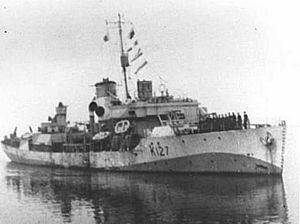Name Algoma Laid down 18 June 1940 Commissioned 11 July 1941 Draft 3.51 m | Ordered 1 February 1940 Launched 17 December 1940 Length 62 m | |
 | ||
Namesake | ||
HMCS Algoma was a Flower-class corvette that served with the Royal Canadian Navy during the Second World War. She served primarily in the Battle of the Atlantic. After the war she was sold to the Venezuelan Navy and renamed Constitución. She was named for the Algoma District of Ontario.
Contents
Background
Flower-class corvettes like Algoma serving with the Royal Canadian Navy during the Second World War were different from earlier and more traditional sail-driven corvettes. The "corvette" designation was created by the French as a class of small warships; the Royal Navy borrowed the term for a period but discontinued its use in 1877. During the hurried preparations for war in the late 1930s, Winston Churchill reactivated the corvette class, needing a name for smaller ships used in an escort capacity, in this case based on a whaling ship design. The generic name "flower" was used to designate the class of these ships, which – in the Royal Navy – were named after flowering plants.
Corvettes commissioned by the Royal Canadian Navy during the Second World War were named after communities for the most part, to better represent the people who took part in building them. This idea was put forth by Admiral Percy W. Nelles. Sponsors were commonly associated with the community for which the ship was named. Royal Navy corvettes were designed as open sea escorts, while Canadian corvettes were developed for coastal auxiliary roles which was exemplified by their minesweeping gear. Eventually the Canadian corvettes would be modified to allow them to perform better on the open seas.
Construction
Algoma was ordered 1 February 1940 as part of the 1939-1940 Flower class building program. She was laid down on 18 June 1940 by Port Arthur Shipbuilding Co. in Port Arthur, Ontario and launched on 17 December 1940. Commissioned on 11 July 1941 in Montreal, Quebec she arrived in Halifax, Nova Scotia on 18 July 1940 to begin her career.
Atlantic service
Algoma served as an ocean escort until May 1942, participating in two severe u-boat attacks on convoys ONS 67 and ONS 92. She was an original member of MOEF Escort Group A-3 (EG A-3). She was replaced in the group by corvettes Mayflower and Trillium. Algoma then went in for refit which took six weeks to complete. Upon returning to active service in July she joined WLEF. She was assigned to Operation Torch convoys where she took part in convoy SC 107 which lost fifteen ships.
Algoma was then placed under command of the Royal Navy escorting convoys to the Mediterranean Sea. She was then returned to the Atlantic as a member of first Western Support Force and then a return to the WLEF, followed by a period with the Quebec Force. She did one quick tour with EG C-4 before arriving at Liverpool, Nova Scotia for a major refit. Algoma returned to service in May 1944, joining EG C-5. She performed three round trips with convoys before joining EG 41 under the command of the Royal Navy's Plymouth Command. She spent the rest of the war patrolling the English Channel.
Post war service
Algoma was paid off on 6 July 1945 at Sydney, Nova Scotia for disposal. She was purchased by the Venezuelan Navy in 1946 and renamed ARV Constitución. She was discarded in 1962.
